Strategic & Operations Management Report: Industry Analysis and M&CO
VerifiedAdded on 2023/04/23
|14
|3398
|277
Report
AI Summary
This report delves into the realm of strategic and operations management, focusing on the clothing industry and the company M&CO. It commences with an introduction outlining the report's objectives, followed by a discussion section. The discussion encompasses a PESTLE analysis of the clothing industry, assessing political, economic, social, technological, legal, and environmental factors. It also examines Porter's five forces, including the bargaining power of buyers and suppliers, the threat of new entrants and substitutes, and competitive rivalry. Furthermore, the report identifies survival and success factors within the clothing industry. The second task involves analyzing M&CO's resources and capabilities, encompassing tangible and intangible assets, and conducting a VRIN analysis to assess the value, rarity, imitability, and non-substitutability of its resources. The report concludes with a summary of the key findings and provides a list of references.
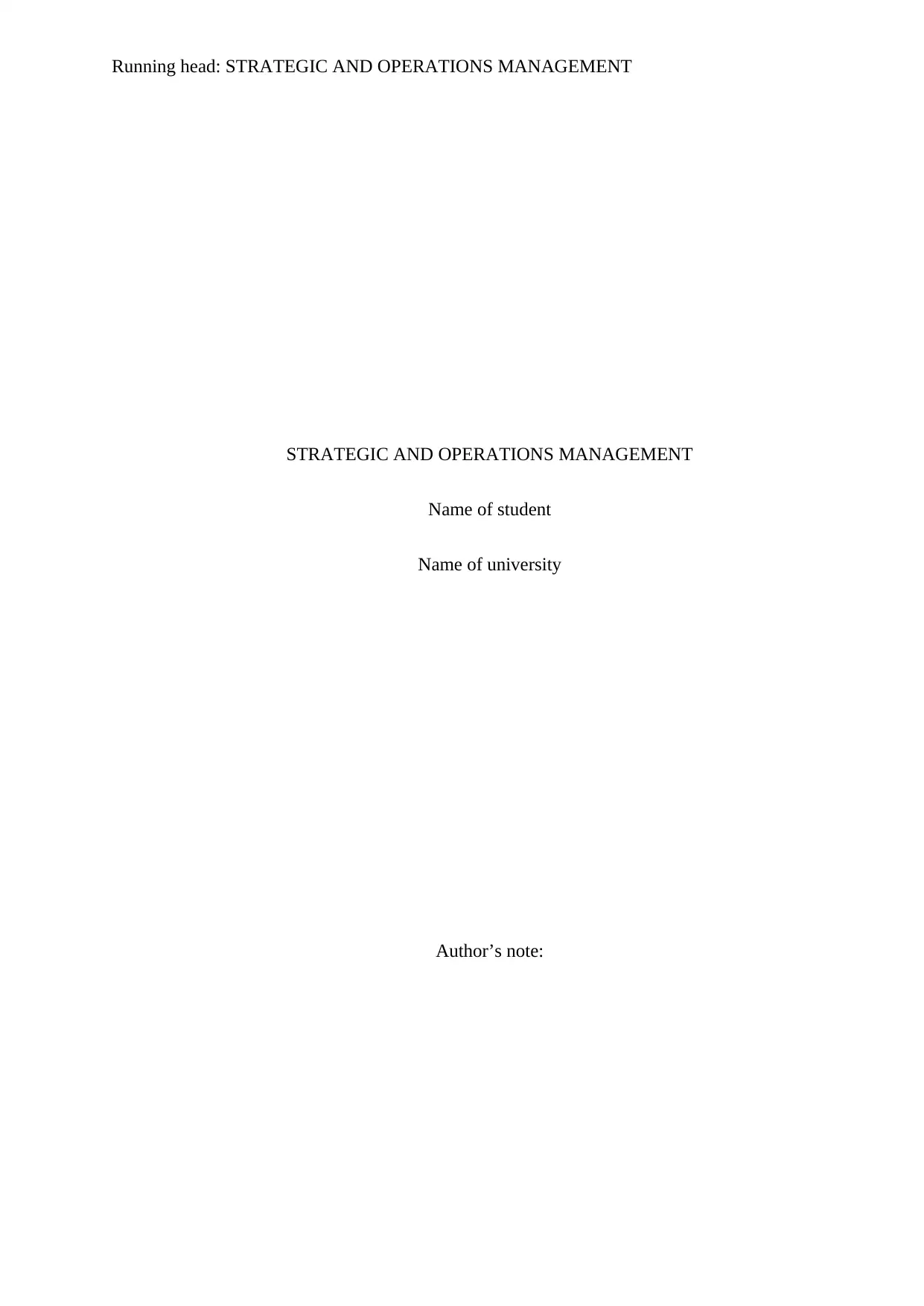
Running head: STRATEGIC AND OPERATIONS MANAGEMENT
STRATEGIC AND OPERATIONS MANAGEMENT
Name of student
Name of university
Author’s note:
STRATEGIC AND OPERATIONS MANAGEMENT
Name of student
Name of university
Author’s note:
Paraphrase This Document
Need a fresh take? Get an instant paraphrase of this document with our AI Paraphraser
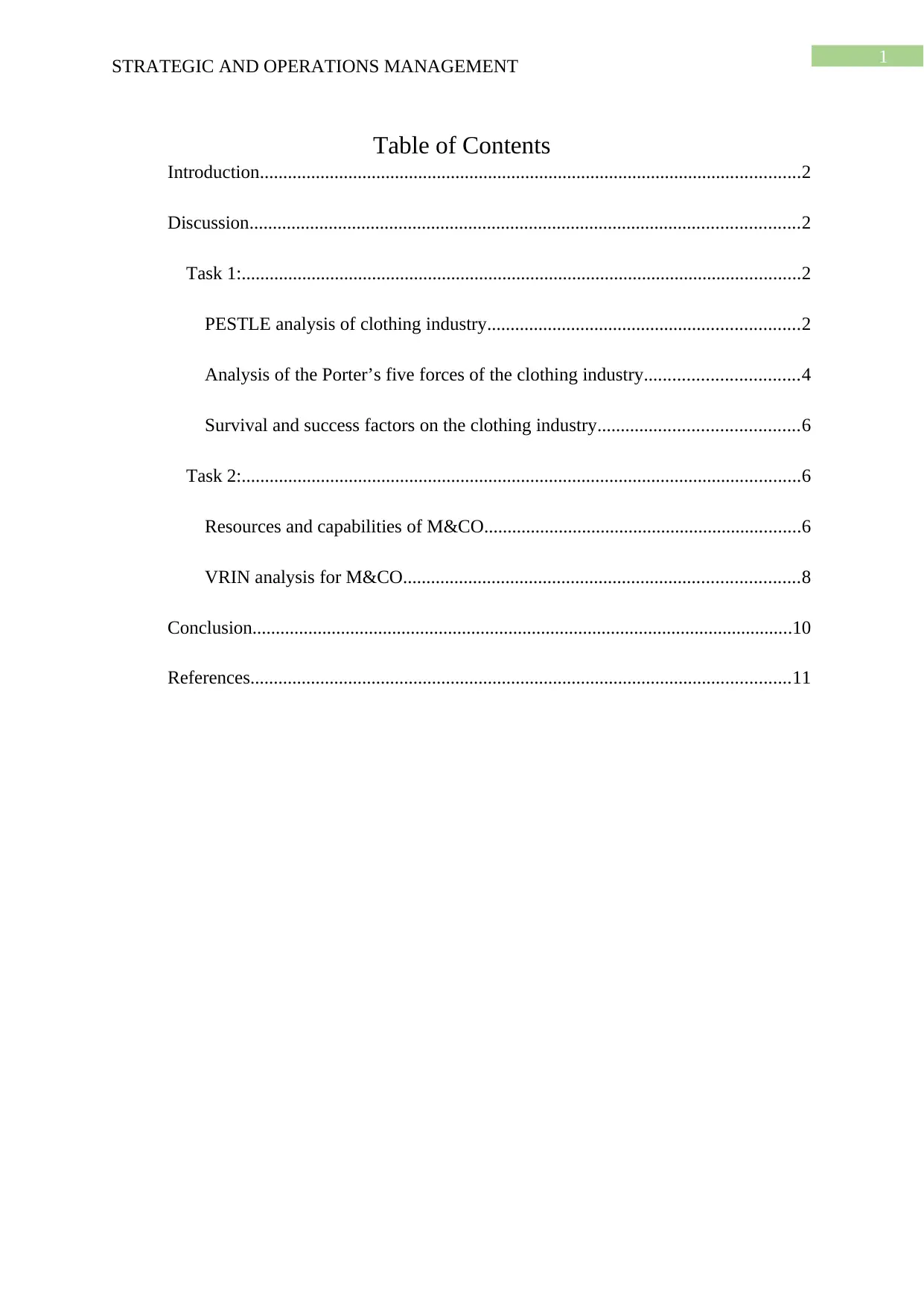
1
STRATEGIC AND OPERATIONS MANAGEMENT
Table of Contents
Introduction....................................................................................................................2
Discussion......................................................................................................................2
Task 1:........................................................................................................................2
PESTLE analysis of clothing industry...................................................................2
Analysis of the Porter’s five forces of the clothing industry.................................4
Survival and success factors on the clothing industry...........................................6
Task 2:........................................................................................................................6
Resources and capabilities of M&CO....................................................................6
VRIN analysis for M&CO.....................................................................................8
Conclusion....................................................................................................................10
References....................................................................................................................11
STRATEGIC AND OPERATIONS MANAGEMENT
Table of Contents
Introduction....................................................................................................................2
Discussion......................................................................................................................2
Task 1:........................................................................................................................2
PESTLE analysis of clothing industry...................................................................2
Analysis of the Porter’s five forces of the clothing industry.................................4
Survival and success factors on the clothing industry...........................................6
Task 2:........................................................................................................................6
Resources and capabilities of M&CO....................................................................6
VRIN analysis for M&CO.....................................................................................8
Conclusion....................................................................................................................10
References....................................................................................................................11
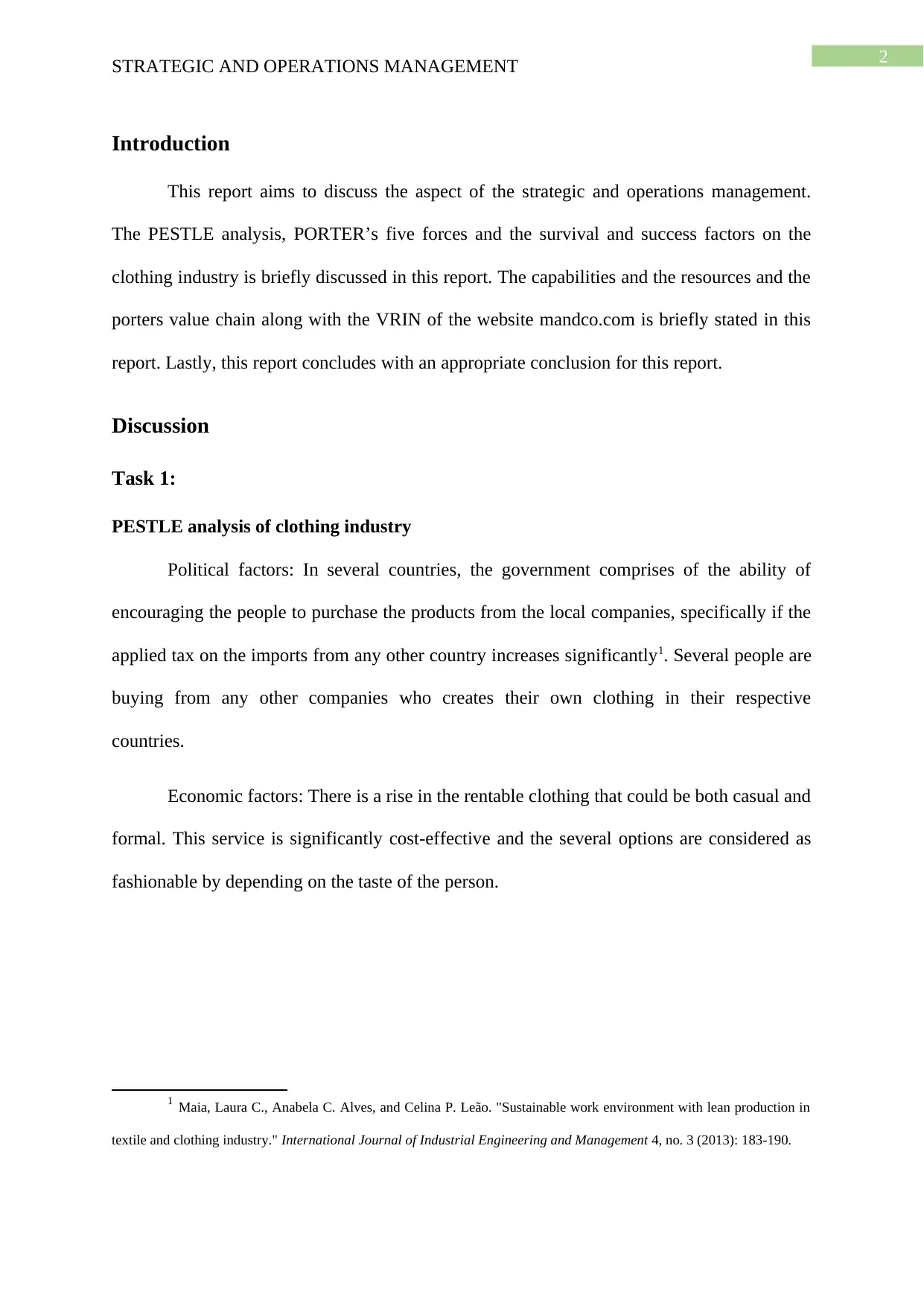
2
STRATEGIC AND OPERATIONS MANAGEMENT
Introduction
This report aims to discuss the aspect of the strategic and operations management.
The PESTLE analysis, PORTER’s five forces and the survival and success factors on the
clothing industry is briefly discussed in this report. The capabilities and the resources and the
porters value chain along with the VRIN of the website mandco.com is briefly stated in this
report. Lastly, this report concludes with an appropriate conclusion for this report.
Discussion
Task 1:
PESTLE analysis of clothing industry
Political factors: In several countries, the government comprises of the ability of
encouraging the people to purchase the products from the local companies, specifically if the
applied tax on the imports from any other country increases significantly1. Several people are
buying from any other companies who creates their own clothing in their respective
countries.
Economic factors: There is a rise in the rentable clothing that could be both casual and
formal. This service is significantly cost-effective and the several options are considered as
fashionable by depending on the taste of the person.
1 Maia, Laura C., Anabela C. Alves, and Celina P. Leão. "Sustainable work environment with lean production in
textile and clothing industry." International Journal of Industrial Engineering and Management 4, no. 3 (2013): 183-190.
STRATEGIC AND OPERATIONS MANAGEMENT
Introduction
This report aims to discuss the aspect of the strategic and operations management.
The PESTLE analysis, PORTER’s five forces and the survival and success factors on the
clothing industry is briefly discussed in this report. The capabilities and the resources and the
porters value chain along with the VRIN of the website mandco.com is briefly stated in this
report. Lastly, this report concludes with an appropriate conclusion for this report.
Discussion
Task 1:
PESTLE analysis of clothing industry
Political factors: In several countries, the government comprises of the ability of
encouraging the people to purchase the products from the local companies, specifically if the
applied tax on the imports from any other country increases significantly1. Several people are
buying from any other companies who creates their own clothing in their respective
countries.
Economic factors: There is a rise in the rentable clothing that could be both casual and
formal. This service is significantly cost-effective and the several options are considered as
fashionable by depending on the taste of the person.
1 Maia, Laura C., Anabela C. Alves, and Celina P. Leão. "Sustainable work environment with lean production in
textile and clothing industry." International Journal of Industrial Engineering and Management 4, no. 3 (2013): 183-190.
⊘ This is a preview!⊘
Do you want full access?
Subscribe today to unlock all pages.

Trusted by 1+ million students worldwide
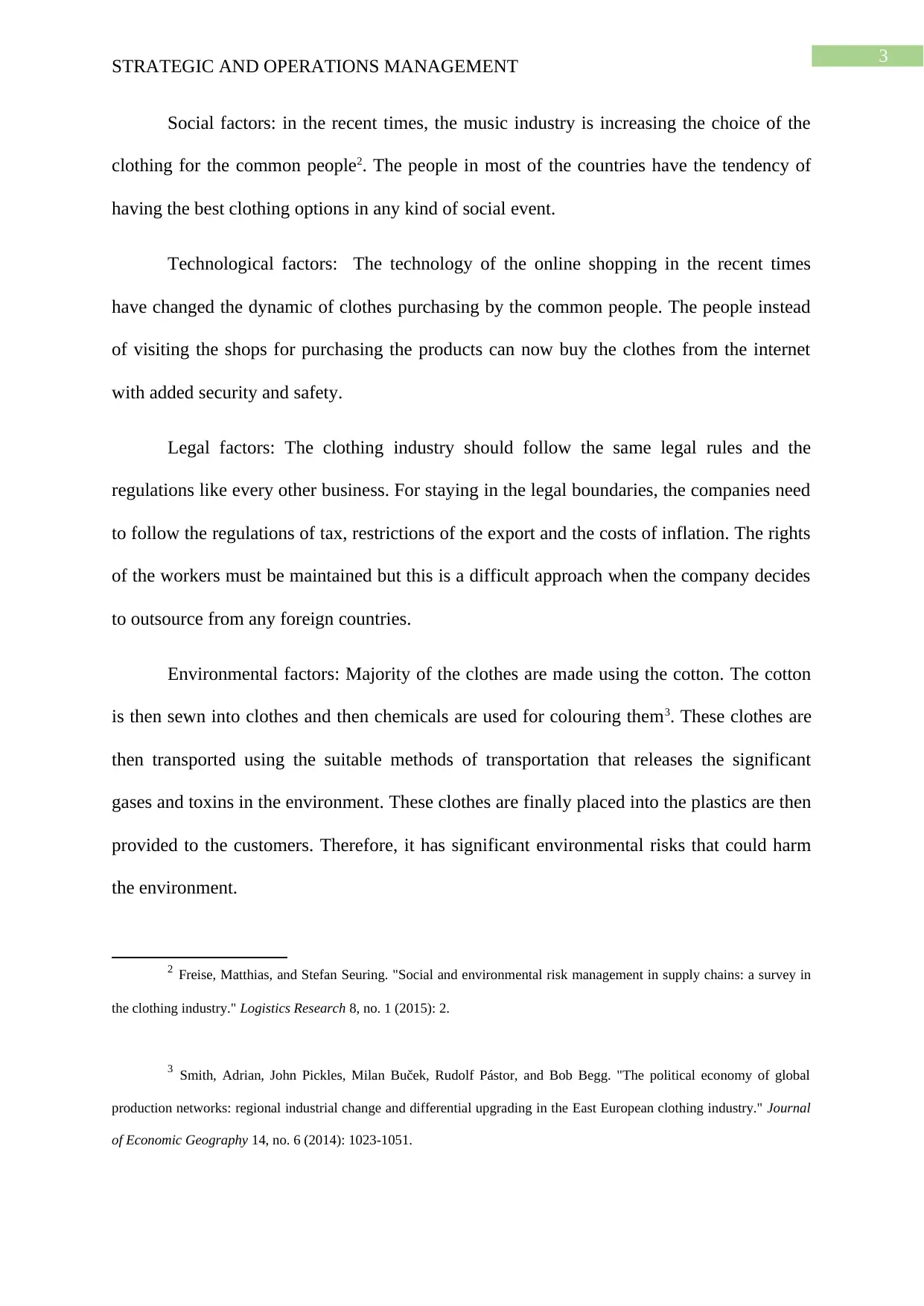
3
STRATEGIC AND OPERATIONS MANAGEMENT
Social factors: in the recent times, the music industry is increasing the choice of the
clothing for the common people2. The people in most of the countries have the tendency of
having the best clothing options in any kind of social event.
Technological factors: The technology of the online shopping in the recent times
have changed the dynamic of clothes purchasing by the common people. The people instead
of visiting the shops for purchasing the products can now buy the clothes from the internet
with added security and safety.
Legal factors: The clothing industry should follow the same legal rules and the
regulations like every other business. For staying in the legal boundaries, the companies need
to follow the regulations of tax, restrictions of the export and the costs of inflation. The rights
of the workers must be maintained but this is a difficult approach when the company decides
to outsource from any foreign countries.
Environmental factors: Majority of the clothes are made using the cotton. The cotton
is then sewn into clothes and then chemicals are used for colouring them3. These clothes are
then transported using the suitable methods of transportation that releases the significant
gases and toxins in the environment. These clothes are finally placed into the plastics are then
provided to the customers. Therefore, it has significant environmental risks that could harm
the environment.
2 Freise, Matthias, and Stefan Seuring. "Social and environmental risk management in supply chains: a survey in
the clothing industry." Logistics Research 8, no. 1 (2015): 2.
3 Smith, Adrian, John Pickles, Milan Buček, Rudolf Pástor, and Bob Begg. "The political economy of global
production networks: regional industrial change and differential upgrading in the East European clothing industry." Journal
of Economic Geography 14, no. 6 (2014): 1023-1051.
STRATEGIC AND OPERATIONS MANAGEMENT
Social factors: in the recent times, the music industry is increasing the choice of the
clothing for the common people2. The people in most of the countries have the tendency of
having the best clothing options in any kind of social event.
Technological factors: The technology of the online shopping in the recent times
have changed the dynamic of clothes purchasing by the common people. The people instead
of visiting the shops for purchasing the products can now buy the clothes from the internet
with added security and safety.
Legal factors: The clothing industry should follow the same legal rules and the
regulations like every other business. For staying in the legal boundaries, the companies need
to follow the regulations of tax, restrictions of the export and the costs of inflation. The rights
of the workers must be maintained but this is a difficult approach when the company decides
to outsource from any foreign countries.
Environmental factors: Majority of the clothes are made using the cotton. The cotton
is then sewn into clothes and then chemicals are used for colouring them3. These clothes are
then transported using the suitable methods of transportation that releases the significant
gases and toxins in the environment. These clothes are finally placed into the plastics are then
provided to the customers. Therefore, it has significant environmental risks that could harm
the environment.
2 Freise, Matthias, and Stefan Seuring. "Social and environmental risk management in supply chains: a survey in
the clothing industry." Logistics Research 8, no. 1 (2015): 2.
3 Smith, Adrian, John Pickles, Milan Buček, Rudolf Pástor, and Bob Begg. "The political economy of global
production networks: regional industrial change and differential upgrading in the East European clothing industry." Journal
of Economic Geography 14, no. 6 (2014): 1023-1051.
Paraphrase This Document
Need a fresh take? Get an instant paraphrase of this document with our AI Paraphraser
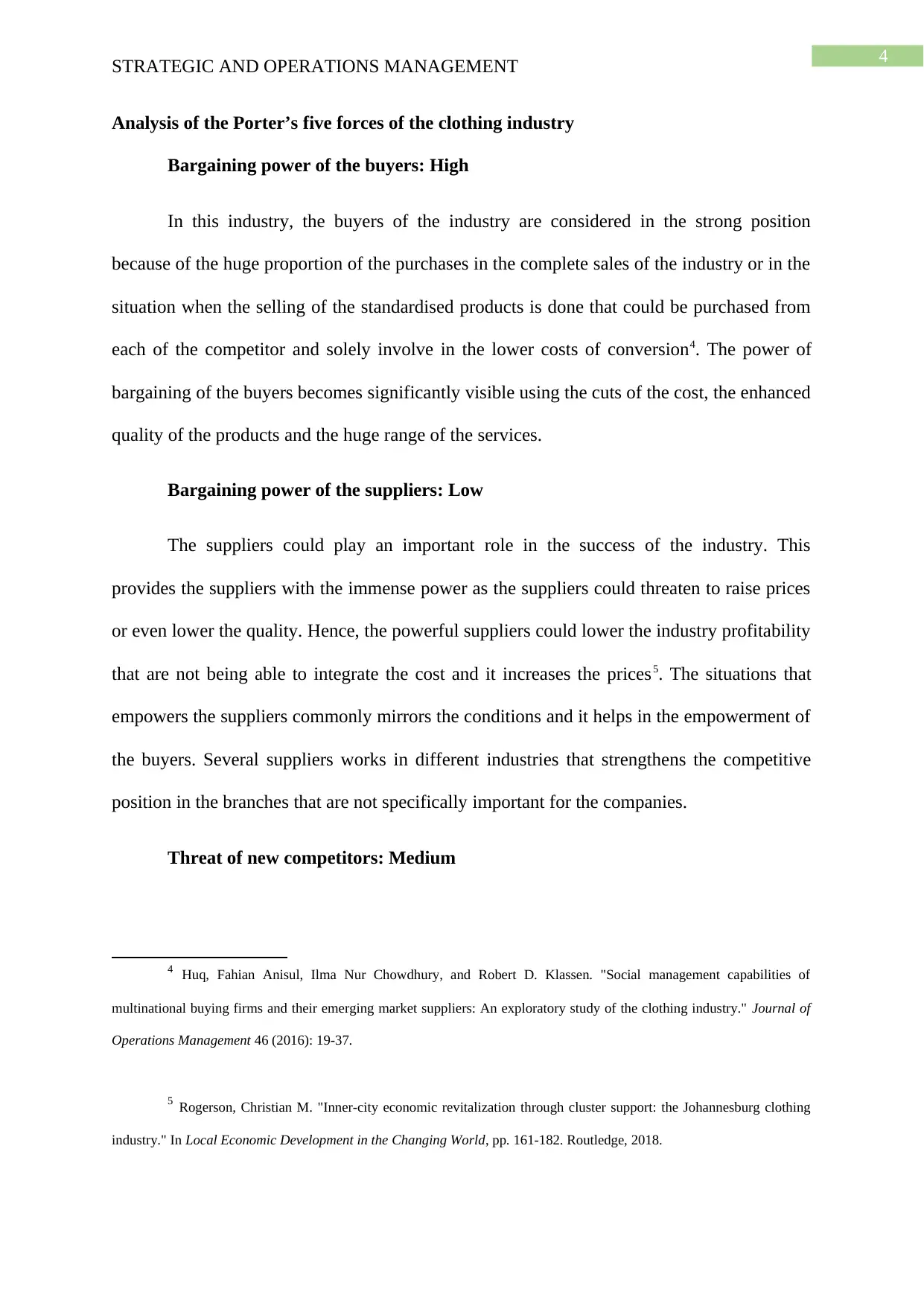
4
STRATEGIC AND OPERATIONS MANAGEMENT
Analysis of the Porter’s five forces of the clothing industry
Bargaining power of the buyers: High
In this industry, the buyers of the industry are considered in the strong position
because of the huge proportion of the purchases in the complete sales of the industry or in the
situation when the selling of the standardised products is done that could be purchased from
each of the competitor and solely involve in the lower costs of conversion4. The power of
bargaining of the buyers becomes significantly visible using the cuts of the cost, the enhanced
quality of the products and the huge range of the services.
Bargaining power of the suppliers: Low
The suppliers could play an important role in the success of the industry. This
provides the suppliers with the immense power as the suppliers could threaten to raise prices
or even lower the quality. Hence, the powerful suppliers could lower the industry profitability
that are not being able to integrate the cost and it increases the prices5. The situations that
empowers the suppliers commonly mirrors the conditions and it helps in the empowerment of
the buyers. Several suppliers works in different industries that strengthens the competitive
position in the branches that are not specifically important for the companies.
Threat of new competitors: Medium
4 Huq, Fahian Anisul, Ilma Nur Chowdhury, and Robert D. Klassen. "Social management capabilities of
multinational buying firms and their emerging market suppliers: An exploratory study of the clothing industry." Journal of
Operations Management 46 (2016): 19-37.
5 Rogerson, Christian M. "Inner-city economic revitalization through cluster support: the Johannesburg clothing
industry." In Local Economic Development in the Changing World, pp. 161-182. Routledge, 2018.
STRATEGIC AND OPERATIONS MANAGEMENT
Analysis of the Porter’s five forces of the clothing industry
Bargaining power of the buyers: High
In this industry, the buyers of the industry are considered in the strong position
because of the huge proportion of the purchases in the complete sales of the industry or in the
situation when the selling of the standardised products is done that could be purchased from
each of the competitor and solely involve in the lower costs of conversion4. The power of
bargaining of the buyers becomes significantly visible using the cuts of the cost, the enhanced
quality of the products and the huge range of the services.
Bargaining power of the suppliers: Low
The suppliers could play an important role in the success of the industry. This
provides the suppliers with the immense power as the suppliers could threaten to raise prices
or even lower the quality. Hence, the powerful suppliers could lower the industry profitability
that are not being able to integrate the cost and it increases the prices5. The situations that
empowers the suppliers commonly mirrors the conditions and it helps in the empowerment of
the buyers. Several suppliers works in different industries that strengthens the competitive
position in the branches that are not specifically important for the companies.
Threat of new competitors: Medium
4 Huq, Fahian Anisul, Ilma Nur Chowdhury, and Robert D. Klassen. "Social management capabilities of
multinational buying firms and their emerging market suppliers: An exploratory study of the clothing industry." Journal of
Operations Management 46 (2016): 19-37.
5 Rogerson, Christian M. "Inner-city economic revitalization through cluster support: the Johannesburg clothing
industry." In Local Economic Development in the Changing World, pp. 161-182. Routledge, 2018.
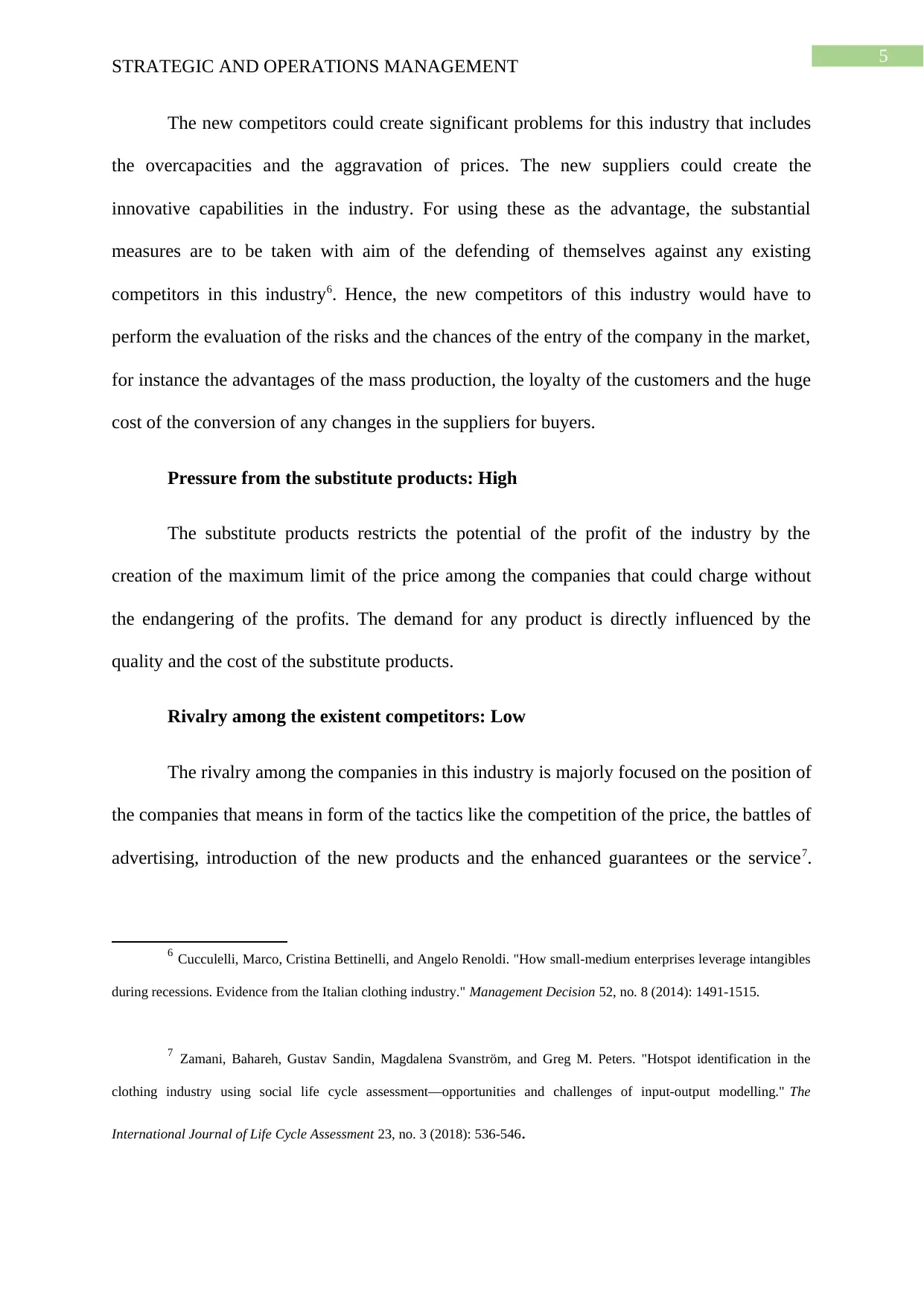
5
STRATEGIC AND OPERATIONS MANAGEMENT
The new competitors could create significant problems for this industry that includes
the overcapacities and the aggravation of prices. The new suppliers could create the
innovative capabilities in the industry. For using these as the advantage, the substantial
measures are to be taken with aim of the defending of themselves against any existing
competitors in this industry6. Hence, the new competitors of this industry would have to
perform the evaluation of the risks and the chances of the entry of the company in the market,
for instance the advantages of the mass production, the loyalty of the customers and the huge
cost of the conversion of any changes in the suppliers for buyers.
Pressure from the substitute products: High
The substitute products restricts the potential of the profit of the industry by the
creation of the maximum limit of the price among the companies that could charge without
the endangering of the profits. The demand for any product is directly influenced by the
quality and the cost of the substitute products.
Rivalry among the existent competitors: Low
The rivalry among the companies in this industry is majorly focused on the position of
the companies that means in form of the tactics like the competition of the price, the battles of
advertising, introduction of the new products and the enhanced guarantees or the service7.
6 Cucculelli, Marco, Cristina Bettinelli, and Angelo Renoldi. "How small-medium enterprises leverage intangibles
during recessions. Evidence from the Italian clothing industry." Management Decision 52, no. 8 (2014): 1491-1515.
7 Zamani, Bahareh, Gustav Sandin, Magdalena Svanström, and Greg M. Peters. "Hotspot identification in the
clothing industry using social life cycle assessment—opportunities and challenges of input-output modelling." The
International Journal of Life Cycle Assessment 23, no. 3 (2018): 536-546.
STRATEGIC AND OPERATIONS MANAGEMENT
The new competitors could create significant problems for this industry that includes
the overcapacities and the aggravation of prices. The new suppliers could create the
innovative capabilities in the industry. For using these as the advantage, the substantial
measures are to be taken with aim of the defending of themselves against any existing
competitors in this industry6. Hence, the new competitors of this industry would have to
perform the evaluation of the risks and the chances of the entry of the company in the market,
for instance the advantages of the mass production, the loyalty of the customers and the huge
cost of the conversion of any changes in the suppliers for buyers.
Pressure from the substitute products: High
The substitute products restricts the potential of the profit of the industry by the
creation of the maximum limit of the price among the companies that could charge without
the endangering of the profits. The demand for any product is directly influenced by the
quality and the cost of the substitute products.
Rivalry among the existent competitors: Low
The rivalry among the companies in this industry is majorly focused on the position of
the companies that means in form of the tactics like the competition of the price, the battles of
advertising, introduction of the new products and the enhanced guarantees or the service7.
6 Cucculelli, Marco, Cristina Bettinelli, and Angelo Renoldi. "How small-medium enterprises leverage intangibles
during recessions. Evidence from the Italian clothing industry." Management Decision 52, no. 8 (2014): 1491-1515.
7 Zamani, Bahareh, Gustav Sandin, Magdalena Svanström, and Greg M. Peters. "Hotspot identification in the
clothing industry using social life cycle assessment—opportunities and challenges of input-output modelling." The
International Journal of Life Cycle Assessment 23, no. 3 (2018): 536-546.
⊘ This is a preview!⊘
Do you want full access?
Subscribe today to unlock all pages.

Trusted by 1+ million students worldwide
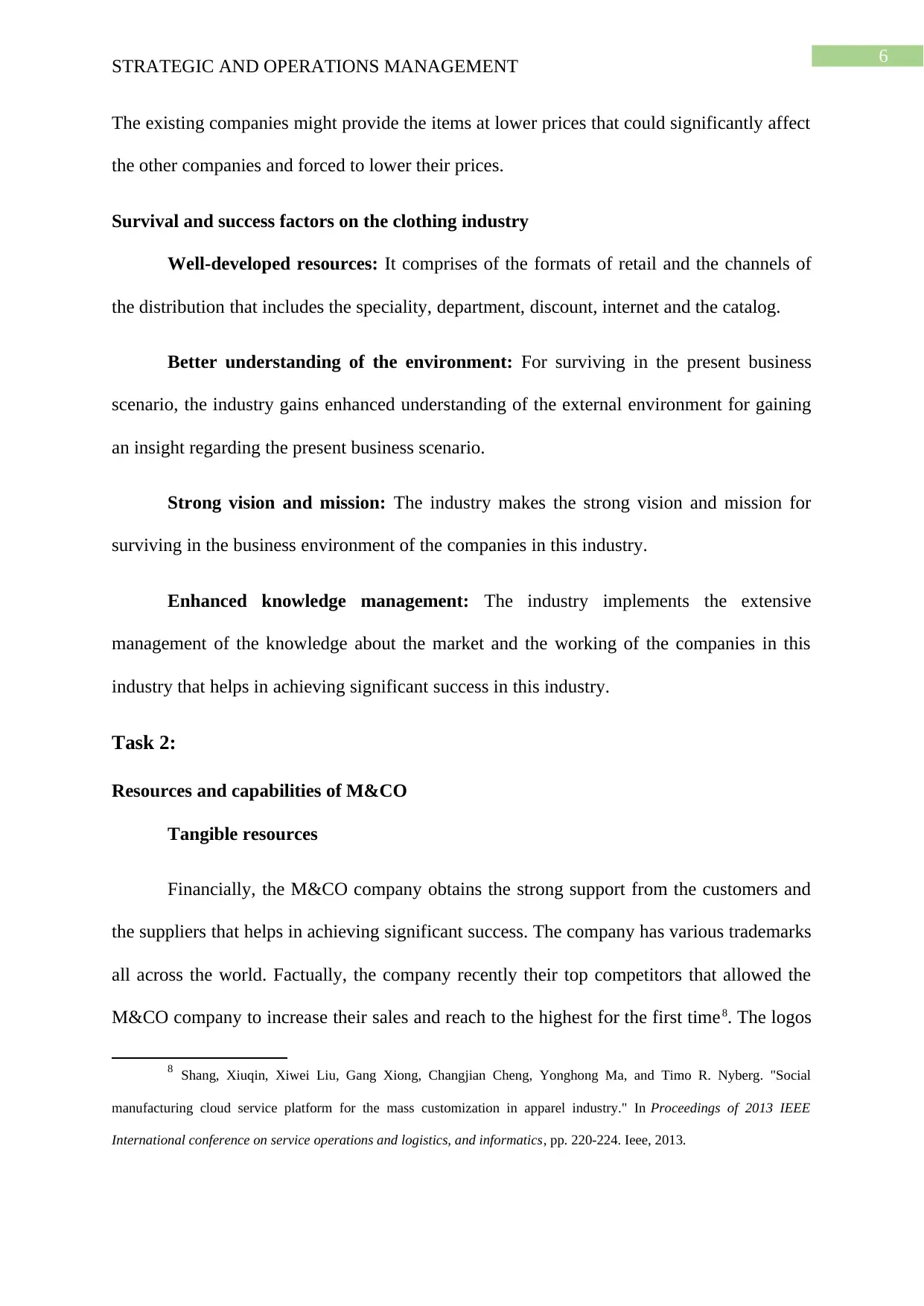
6
STRATEGIC AND OPERATIONS MANAGEMENT
The existing companies might provide the items at lower prices that could significantly affect
the other companies and forced to lower their prices.
Survival and success factors on the clothing industry
Well-developed resources: It comprises of the formats of retail and the channels of
the distribution that includes the speciality, department, discount, internet and the catalog.
Better understanding of the environment: For surviving in the present business
scenario, the industry gains enhanced understanding of the external environment for gaining
an insight regarding the present business scenario.
Strong vision and mission: The industry makes the strong vision and mission for
surviving in the business environment of the companies in this industry.
Enhanced knowledge management: The industry implements the extensive
management of the knowledge about the market and the working of the companies in this
industry that helps in achieving significant success in this industry.
Task 2:
Resources and capabilities of M&CO
Tangible resources
Financially, the M&CO company obtains the strong support from the customers and
the suppliers that helps in achieving significant success. The company has various trademarks
all across the world. Factually, the company recently their top competitors that allowed the
M&CO company to increase their sales and reach to the highest for the first time8. The logos
8 Shang, Xiuqin, Xiwei Liu, Gang Xiong, Changjian Cheng, Yonghong Ma, and Timo R. Nyberg. "Social
manufacturing cloud service platform for the mass customization in apparel industry." In Proceedings of 2013 IEEE
International conference on service operations and logistics, and informatics, pp. 220-224. Ieee, 2013.
STRATEGIC AND OPERATIONS MANAGEMENT
The existing companies might provide the items at lower prices that could significantly affect
the other companies and forced to lower their prices.
Survival and success factors on the clothing industry
Well-developed resources: It comprises of the formats of retail and the channels of
the distribution that includes the speciality, department, discount, internet and the catalog.
Better understanding of the environment: For surviving in the present business
scenario, the industry gains enhanced understanding of the external environment for gaining
an insight regarding the present business scenario.
Strong vision and mission: The industry makes the strong vision and mission for
surviving in the business environment of the companies in this industry.
Enhanced knowledge management: The industry implements the extensive
management of the knowledge about the market and the working of the companies in this
industry that helps in achieving significant success in this industry.
Task 2:
Resources and capabilities of M&CO
Tangible resources
Financially, the M&CO company obtains the strong support from the customers and
the suppliers that helps in achieving significant success. The company has various trademarks
all across the world. Factually, the company recently their top competitors that allowed the
M&CO company to increase their sales and reach to the highest for the first time8. The logos
8 Shang, Xiuqin, Xiwei Liu, Gang Xiong, Changjian Cheng, Yonghong Ma, and Timo R. Nyberg. "Social
manufacturing cloud service platform for the mass customization in apparel industry." In Proceedings of 2013 IEEE
International conference on service operations and logistics, and informatics, pp. 220-224. Ieee, 2013.
Paraphrase This Document
Need a fresh take? Get an instant paraphrase of this document with our AI Paraphraser
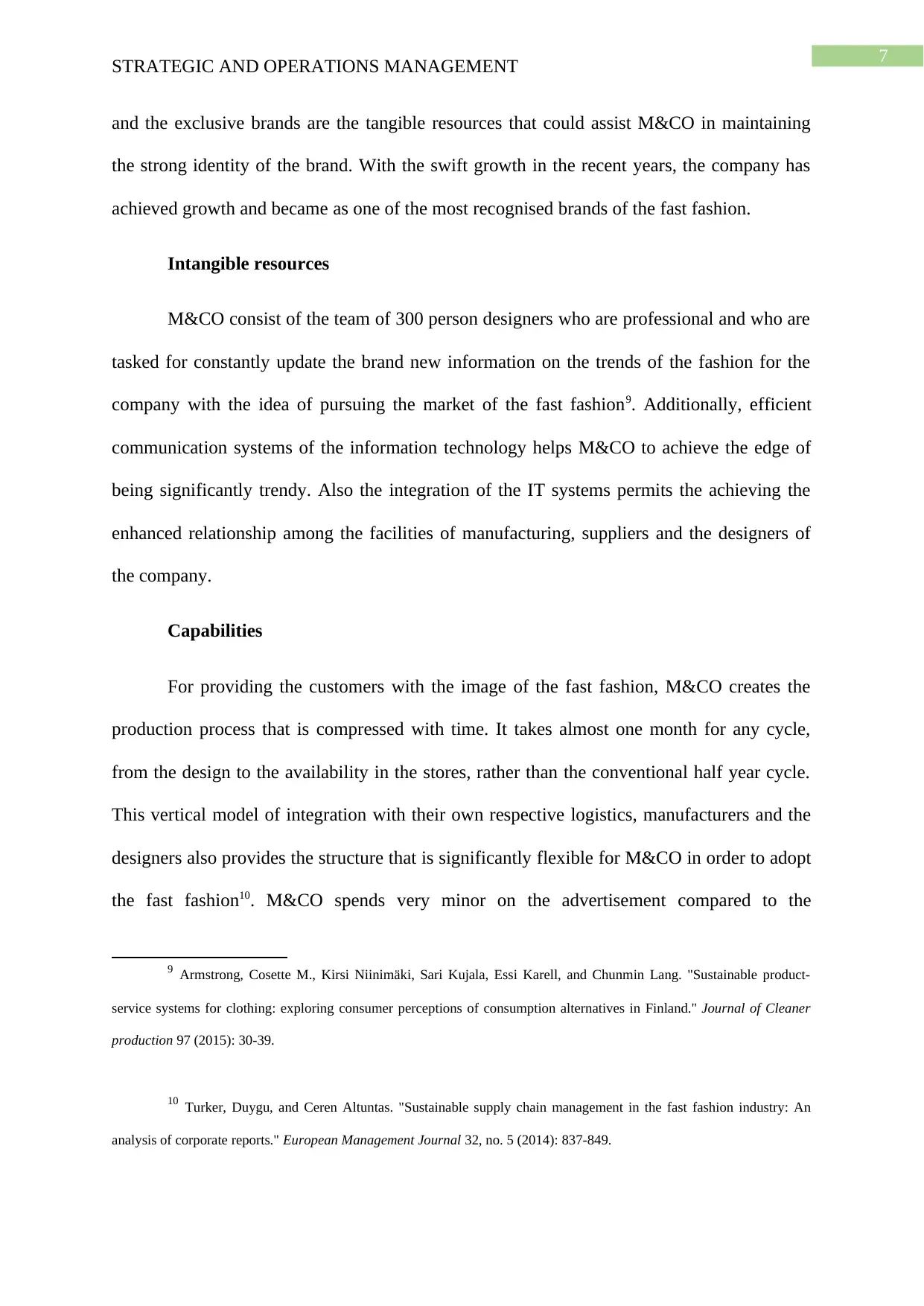
7
STRATEGIC AND OPERATIONS MANAGEMENT
and the exclusive brands are the tangible resources that could assist M&CO in maintaining
the strong identity of the brand. With the swift growth in the recent years, the company has
achieved growth and became as one of the most recognised brands of the fast fashion.
Intangible resources
M&CO consist of the team of 300 person designers who are professional and who are
tasked for constantly update the brand new information on the trends of the fashion for the
company with the idea of pursuing the market of the fast fashion9. Additionally, efficient
communication systems of the information technology helps M&CO to achieve the edge of
being significantly trendy. Also the integration of the IT systems permits the achieving the
enhanced relationship among the facilities of manufacturing, suppliers and the designers of
the company.
Capabilities
For providing the customers with the image of the fast fashion, M&CO creates the
production process that is compressed with time. It takes almost one month for any cycle,
from the design to the availability in the stores, rather than the conventional half year cycle.
This vertical model of integration with their own respective logistics, manufacturers and the
designers also provides the structure that is significantly flexible for M&CO in order to adopt
the fast fashion10. M&CO spends very minor on the advertisement compared to the
9 Armstrong, Cosette M., Kirsi Niinimäki, Sari Kujala, Essi Karell, and Chunmin Lang. "Sustainable product-
service systems for clothing: exploring consumer perceptions of consumption alternatives in Finland." Journal of Cleaner
production 97 (2015): 30-39.
10 Turker, Duygu, and Ceren Altuntas. "Sustainable supply chain management in the fast fashion industry: An
analysis of corporate reports." European Management Journal 32, no. 5 (2014): 837-849.
STRATEGIC AND OPERATIONS MANAGEMENT
and the exclusive brands are the tangible resources that could assist M&CO in maintaining
the strong identity of the brand. With the swift growth in the recent years, the company has
achieved growth and became as one of the most recognised brands of the fast fashion.
Intangible resources
M&CO consist of the team of 300 person designers who are professional and who are
tasked for constantly update the brand new information on the trends of the fashion for the
company with the idea of pursuing the market of the fast fashion9. Additionally, efficient
communication systems of the information technology helps M&CO to achieve the edge of
being significantly trendy. Also the integration of the IT systems permits the achieving the
enhanced relationship among the facilities of manufacturing, suppliers and the designers of
the company.
Capabilities
For providing the customers with the image of the fast fashion, M&CO creates the
production process that is compressed with time. It takes almost one month for any cycle,
from the design to the availability in the stores, rather than the conventional half year cycle.
This vertical model of integration with their own respective logistics, manufacturers and the
designers also provides the structure that is significantly flexible for M&CO in order to adopt
the fast fashion10. M&CO spends very minor on the advertisement compared to the
9 Armstrong, Cosette M., Kirsi Niinimäki, Sari Kujala, Essi Karell, and Chunmin Lang. "Sustainable product-
service systems for clothing: exploring consumer perceptions of consumption alternatives in Finland." Journal of Cleaner
production 97 (2015): 30-39.
10 Turker, Duygu, and Ceren Altuntas. "Sustainable supply chain management in the fast fashion industry: An
analysis of corporate reports." European Management Journal 32, no. 5 (2014): 837-849.
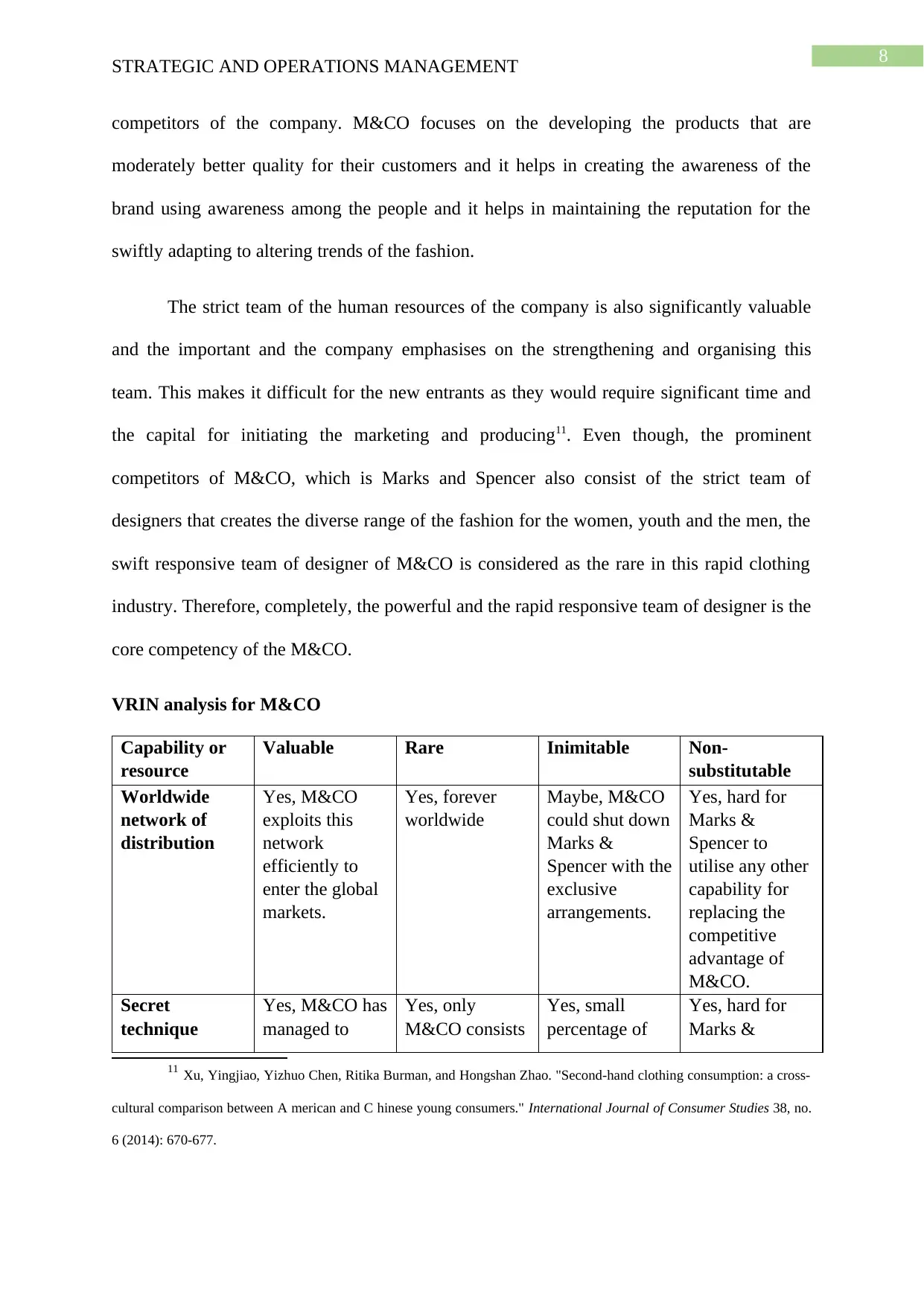
8
STRATEGIC AND OPERATIONS MANAGEMENT
competitors of the company. M&CO focuses on the developing the products that are
moderately better quality for their customers and it helps in creating the awareness of the
brand using awareness among the people and it helps in maintaining the reputation for the
swiftly adapting to altering trends of the fashion.
The strict team of the human resources of the company is also significantly valuable
and the important and the company emphasises on the strengthening and organising this
team. This makes it difficult for the new entrants as they would require significant time and
the capital for initiating the marketing and producing11. Even though, the prominent
competitors of M&CO, which is Marks and Spencer also consist of the strict team of
designers that creates the diverse range of the fashion for the women, youth and the men, the
swift responsive team of designer of M&CO is considered as the rare in this rapid clothing
industry. Therefore, completely, the powerful and the rapid responsive team of designer is the
core competency of the M&CO.
VRIN analysis for M&CO
Capability or
resource
Valuable Rare Inimitable Non-
substitutable
Worldwide
network of
distribution
Yes, M&CO
exploits this
network
efficiently to
enter the global
markets.
Yes, forever
worldwide
Maybe, M&CO
could shut down
Marks &
Spencer with the
exclusive
arrangements.
Yes, hard for
Marks &
Spencer to
utilise any other
capability for
replacing the
competitive
advantage of
M&CO.
Secret
technique
Yes, M&CO has
managed to
Yes, only
M&CO consists
Yes, small
percentage of
Yes, hard for
Marks &
11 Xu, Yingjiao, Yizhuo Chen, Ritika Burman, and Hongshan Zhao. "Second‐hand clothing consumption: a cross‐
cultural comparison between A merican and C hinese young consumers." International Journal of Consumer Studies 38, no.
6 (2014): 670-677.
STRATEGIC AND OPERATIONS MANAGEMENT
competitors of the company. M&CO focuses on the developing the products that are
moderately better quality for their customers and it helps in creating the awareness of the
brand using awareness among the people and it helps in maintaining the reputation for the
swiftly adapting to altering trends of the fashion.
The strict team of the human resources of the company is also significantly valuable
and the important and the company emphasises on the strengthening and organising this
team. This makes it difficult for the new entrants as they would require significant time and
the capital for initiating the marketing and producing11. Even though, the prominent
competitors of M&CO, which is Marks and Spencer also consist of the strict team of
designers that creates the diverse range of the fashion for the women, youth and the men, the
swift responsive team of designer of M&CO is considered as the rare in this rapid clothing
industry. Therefore, completely, the powerful and the rapid responsive team of designer is the
core competency of the M&CO.
VRIN analysis for M&CO
Capability or
resource
Valuable Rare Inimitable Non-
substitutable
Worldwide
network of
distribution
Yes, M&CO
exploits this
network
efficiently to
enter the global
markets.
Yes, forever
worldwide
Maybe, M&CO
could shut down
Marks &
Spencer with the
exclusive
arrangements.
Yes, hard for
Marks &
Spencer to
utilise any other
capability for
replacing the
competitive
advantage of
M&CO.
Secret
technique
Yes, M&CO has
managed to
Yes, only
M&CO consists
Yes, small
percentage of
Yes, hard for
Marks &
11 Xu, Yingjiao, Yizhuo Chen, Ritika Burman, and Hongshan Zhao. "Second‐hand clothing consumption: a cross‐
cultural comparison between A merican and C hinese young consumers." International Journal of Consumer Studies 38, no.
6 (2014): 670-677.
⊘ This is a preview!⊘
Do you want full access?
Subscribe today to unlock all pages.

Trusted by 1+ million students worldwide
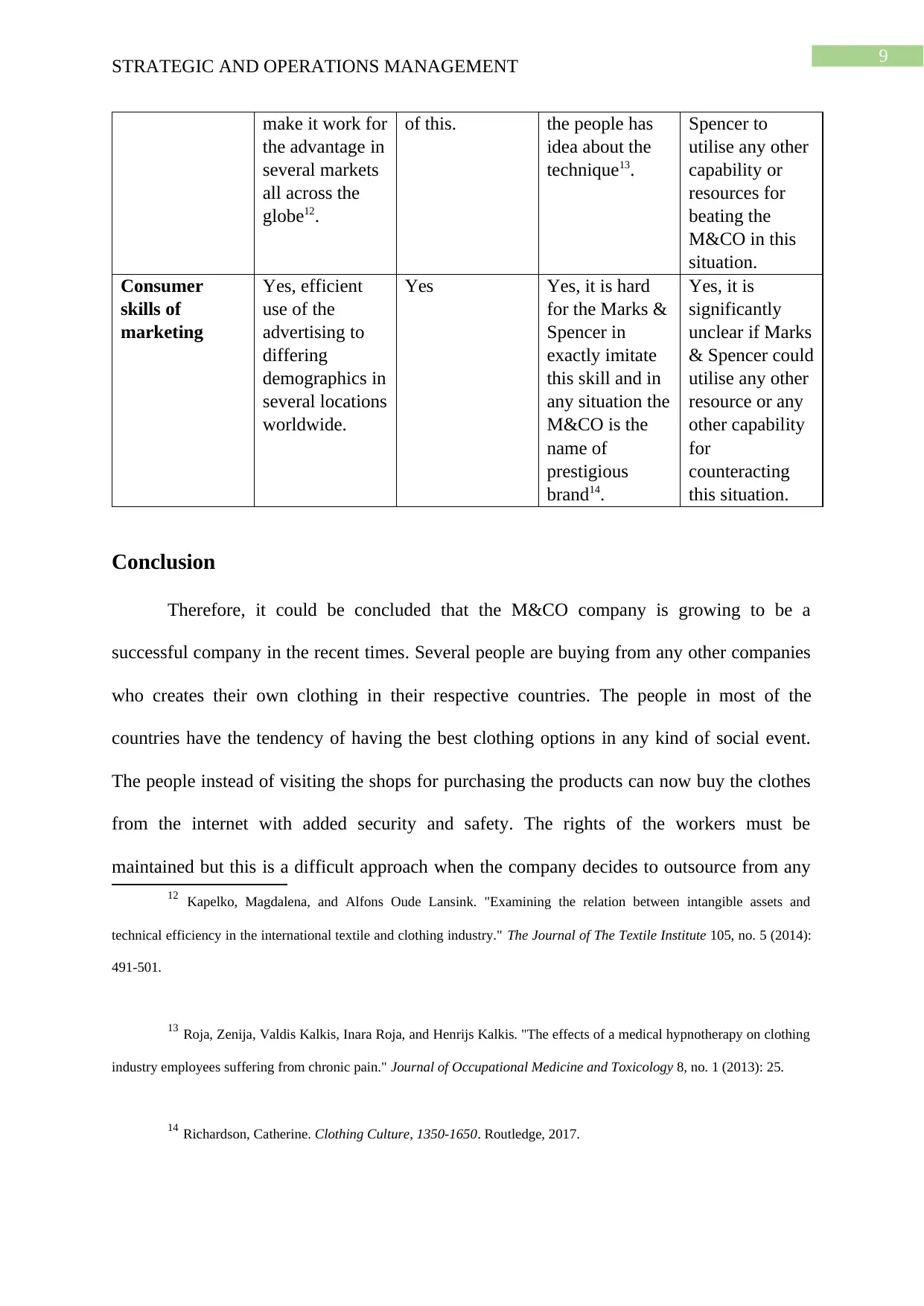
9
STRATEGIC AND OPERATIONS MANAGEMENT
make it work for
the advantage in
several markets
all across the
globe12.
of this. the people has
idea about the
technique13.
Spencer to
utilise any other
capability or
resources for
beating the
M&CO in this
situation.
Consumer
skills of
marketing
Yes, efficient
use of the
advertising to
differing
demographics in
several locations
worldwide.
Yes Yes, it is hard
for the Marks &
Spencer in
exactly imitate
this skill and in
any situation the
M&CO is the
name of
prestigious
brand14.
Yes, it is
significantly
unclear if Marks
& Spencer could
utilise any other
resource or any
other capability
for
counteracting
this situation.
Conclusion
Therefore, it could be concluded that the M&CO company is growing to be a
successful company in the recent times. Several people are buying from any other companies
who creates their own clothing in their respective countries. The people in most of the
countries have the tendency of having the best clothing options in any kind of social event.
The people instead of visiting the shops for purchasing the products can now buy the clothes
from the internet with added security and safety. The rights of the workers must be
maintained but this is a difficult approach when the company decides to outsource from any
12 Kapelko, Magdalena, and Alfons Oude Lansink. "Examining the relation between intangible assets and
technical efficiency in the international textile and clothing industry." The Journal of The Textile Institute 105, no. 5 (2014):
491-501.
13 Roja, Zenija, Valdis Kalkis, Inara Roja, and Henrijs Kalkis. "The effects of a medical hypnotherapy on clothing
industry employees suffering from chronic pain." Journal of Occupational Medicine and Toxicology 8, no. 1 (2013): 25.
14 Richardson, Catherine. Clothing Culture, 1350-1650. Routledge, 2017.
STRATEGIC AND OPERATIONS MANAGEMENT
make it work for
the advantage in
several markets
all across the
globe12.
of this. the people has
idea about the
technique13.
Spencer to
utilise any other
capability or
resources for
beating the
M&CO in this
situation.
Consumer
skills of
marketing
Yes, efficient
use of the
advertising to
differing
demographics in
several locations
worldwide.
Yes Yes, it is hard
for the Marks &
Spencer in
exactly imitate
this skill and in
any situation the
M&CO is the
name of
prestigious
brand14.
Yes, it is
significantly
unclear if Marks
& Spencer could
utilise any other
resource or any
other capability
for
counteracting
this situation.
Conclusion
Therefore, it could be concluded that the M&CO company is growing to be a
successful company in the recent times. Several people are buying from any other companies
who creates their own clothing in their respective countries. The people in most of the
countries have the tendency of having the best clothing options in any kind of social event.
The people instead of visiting the shops for purchasing the products can now buy the clothes
from the internet with added security and safety. The rights of the workers must be
maintained but this is a difficult approach when the company decides to outsource from any
12 Kapelko, Magdalena, and Alfons Oude Lansink. "Examining the relation between intangible assets and
technical efficiency in the international textile and clothing industry." The Journal of The Textile Institute 105, no. 5 (2014):
491-501.
13 Roja, Zenija, Valdis Kalkis, Inara Roja, and Henrijs Kalkis. "The effects of a medical hypnotherapy on clothing
industry employees suffering from chronic pain." Journal of Occupational Medicine and Toxicology 8, no. 1 (2013): 25.
14 Richardson, Catherine. Clothing Culture, 1350-1650. Routledge, 2017.
Paraphrase This Document
Need a fresh take? Get an instant paraphrase of this document with our AI Paraphraser
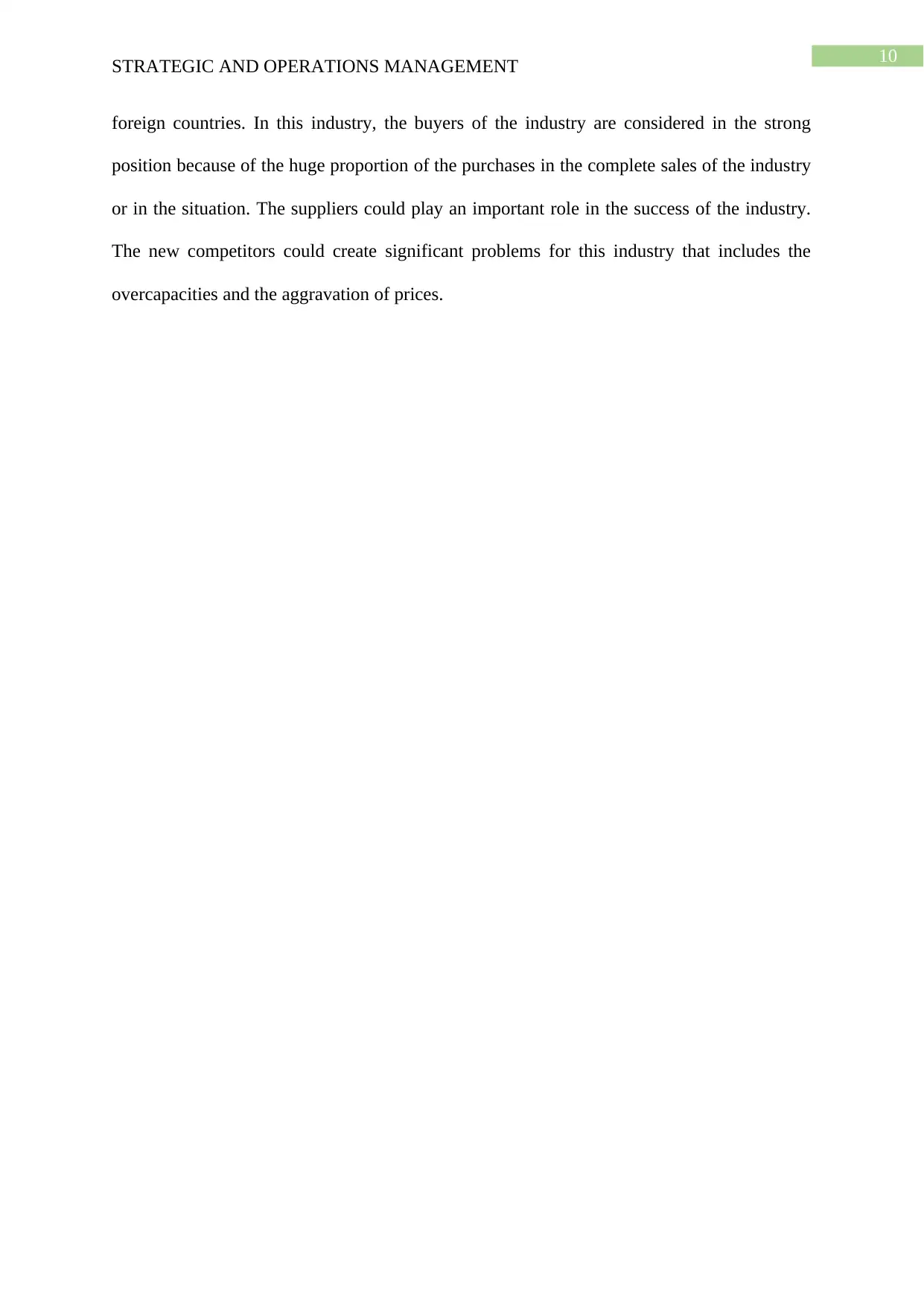
10
STRATEGIC AND OPERATIONS MANAGEMENT
foreign countries. In this industry, the buyers of the industry are considered in the strong
position because of the huge proportion of the purchases in the complete sales of the industry
or in the situation. The suppliers could play an important role in the success of the industry.
The new competitors could create significant problems for this industry that includes the
overcapacities and the aggravation of prices.
STRATEGIC AND OPERATIONS MANAGEMENT
foreign countries. In this industry, the buyers of the industry are considered in the strong
position because of the huge proportion of the purchases in the complete sales of the industry
or in the situation. The suppliers could play an important role in the success of the industry.
The new competitors could create significant problems for this industry that includes the
overcapacities and the aggravation of prices.
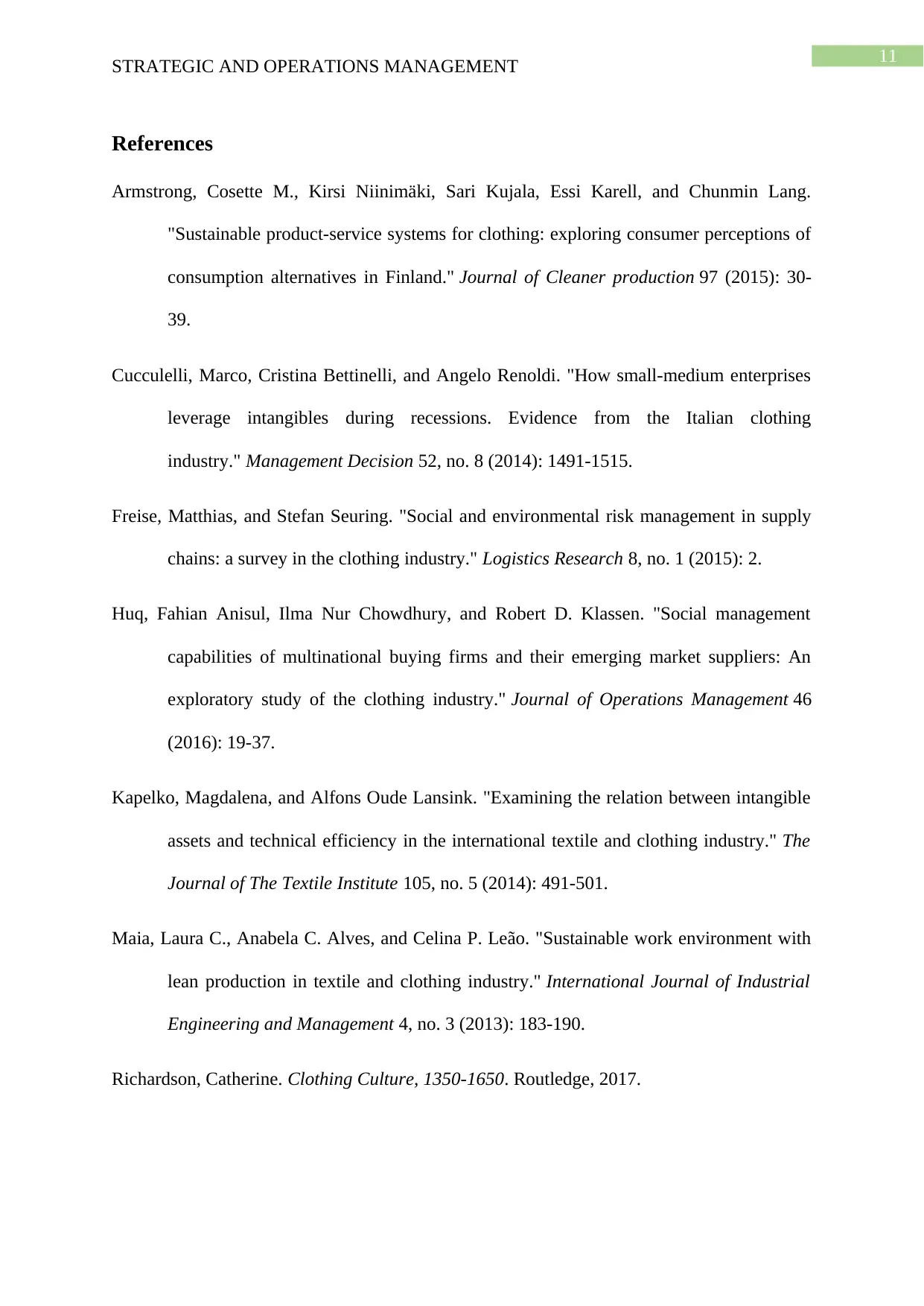
11
STRATEGIC AND OPERATIONS MANAGEMENT
References
Armstrong, Cosette M., Kirsi Niinimäki, Sari Kujala, Essi Karell, and Chunmin Lang.
"Sustainable product-service systems for clothing: exploring consumer perceptions of
consumption alternatives in Finland." Journal of Cleaner production 97 (2015): 30-
39.
Cucculelli, Marco, Cristina Bettinelli, and Angelo Renoldi. "How small-medium enterprises
leverage intangibles during recessions. Evidence from the Italian clothing
industry." Management Decision 52, no. 8 (2014): 1491-1515.
Freise, Matthias, and Stefan Seuring. "Social and environmental risk management in supply
chains: a survey in the clothing industry." Logistics Research 8, no. 1 (2015): 2.
Huq, Fahian Anisul, Ilma Nur Chowdhury, and Robert D. Klassen. "Social management
capabilities of multinational buying firms and their emerging market suppliers: An
exploratory study of the clothing industry." Journal of Operations Management 46
(2016): 19-37.
Kapelko, Magdalena, and Alfons Oude Lansink. "Examining the relation between intangible
assets and technical efficiency in the international textile and clothing industry." The
Journal of The Textile Institute 105, no. 5 (2014): 491-501.
Maia, Laura C., Anabela C. Alves, and Celina P. Leão. "Sustainable work environment with
lean production in textile and clothing industry." International Journal of Industrial
Engineering and Management 4, no. 3 (2013): 183-190.
Richardson, Catherine. Clothing Culture, 1350-1650. Routledge, 2017.
STRATEGIC AND OPERATIONS MANAGEMENT
References
Armstrong, Cosette M., Kirsi Niinimäki, Sari Kujala, Essi Karell, and Chunmin Lang.
"Sustainable product-service systems for clothing: exploring consumer perceptions of
consumption alternatives in Finland." Journal of Cleaner production 97 (2015): 30-
39.
Cucculelli, Marco, Cristina Bettinelli, and Angelo Renoldi. "How small-medium enterprises
leverage intangibles during recessions. Evidence from the Italian clothing
industry." Management Decision 52, no. 8 (2014): 1491-1515.
Freise, Matthias, and Stefan Seuring. "Social and environmental risk management in supply
chains: a survey in the clothing industry." Logistics Research 8, no. 1 (2015): 2.
Huq, Fahian Anisul, Ilma Nur Chowdhury, and Robert D. Klassen. "Social management
capabilities of multinational buying firms and their emerging market suppliers: An
exploratory study of the clothing industry." Journal of Operations Management 46
(2016): 19-37.
Kapelko, Magdalena, and Alfons Oude Lansink. "Examining the relation between intangible
assets and technical efficiency in the international textile and clothing industry." The
Journal of The Textile Institute 105, no. 5 (2014): 491-501.
Maia, Laura C., Anabela C. Alves, and Celina P. Leão. "Sustainable work environment with
lean production in textile and clothing industry." International Journal of Industrial
Engineering and Management 4, no. 3 (2013): 183-190.
Richardson, Catherine. Clothing Culture, 1350-1650. Routledge, 2017.
⊘ This is a preview!⊘
Do you want full access?
Subscribe today to unlock all pages.

Trusted by 1+ million students worldwide
1 out of 14
Related Documents
Your All-in-One AI-Powered Toolkit for Academic Success.
+13062052269
info@desklib.com
Available 24*7 on WhatsApp / Email
![[object Object]](/_next/static/media/star-bottom.7253800d.svg)
Unlock your academic potential
Copyright © 2020–2025 A2Z Services. All Rights Reserved. Developed and managed by ZUCOL.





